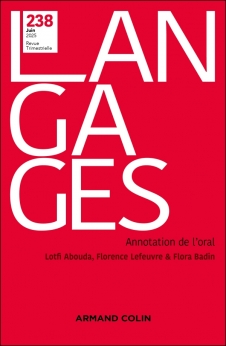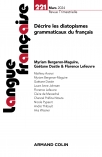
LANGAGES N° 238 (2/2025)
Pour acheter ce numéro, contactez-nous
Recevez les numéros de l'année en cours et accédez à l'intégralité des articles en ligne.
Cet article a pour objectif de montrer que les marqueurs discursifs ne sont pas placés sur la chaîne syntagmatique de façon aléatoire mais dans des positions récurrentes, en lien avec les unités de discours. Il s’appuie sur une annotation topologique effectuée via TXM-0.8.1 sur un corpus d’environ un million de mots. Cette étude aboutit à deux résultats. Premièrement, il apparaît que l’annotation topologique dépend du choix des paramètres utilisés, notamment des unités de discours sélectionnées (unité prédicative, énoncé, tour de parole) et des zones (frontale, médiane, finale) identifiées. Deuxièmement, les marqueurs étudiés, tu sais et tu vois, se situent régulièrement aux bornes d’unités prédicatives verbales, en position initiale le plus souvent pour tu sais et de façon plus équilibrée, en position initiale ou finale, pour tu vois. Ils délimitent en outre certains segments averbaux, comme les unités thématiques ou les ajouts.
The aim of this article is to show that discourse markers are not placed randomly on the syntagmatic chain but in recurrent positions, in relation to discourse units. It is based on a topological annotation carried out using TXM-0.8.1 on a corpus of around one million words. The study produced two results. Firstly, it appears that topological annotation depends on the choice of parameters used, in particular the discourse units selected (predicative unit, utterance, turn of speech) and the zones (frontal, medial, final) identified. Secondly, the markers studied, tu sais and tu vois, are regularly located at the boundaries of verbal predicative units, most often in the initial position for tu sais and in a more balanced way, in the initial or final position, for tu vois. They also help to distinguish certain preverbal segments, such as thematic units or additions.
